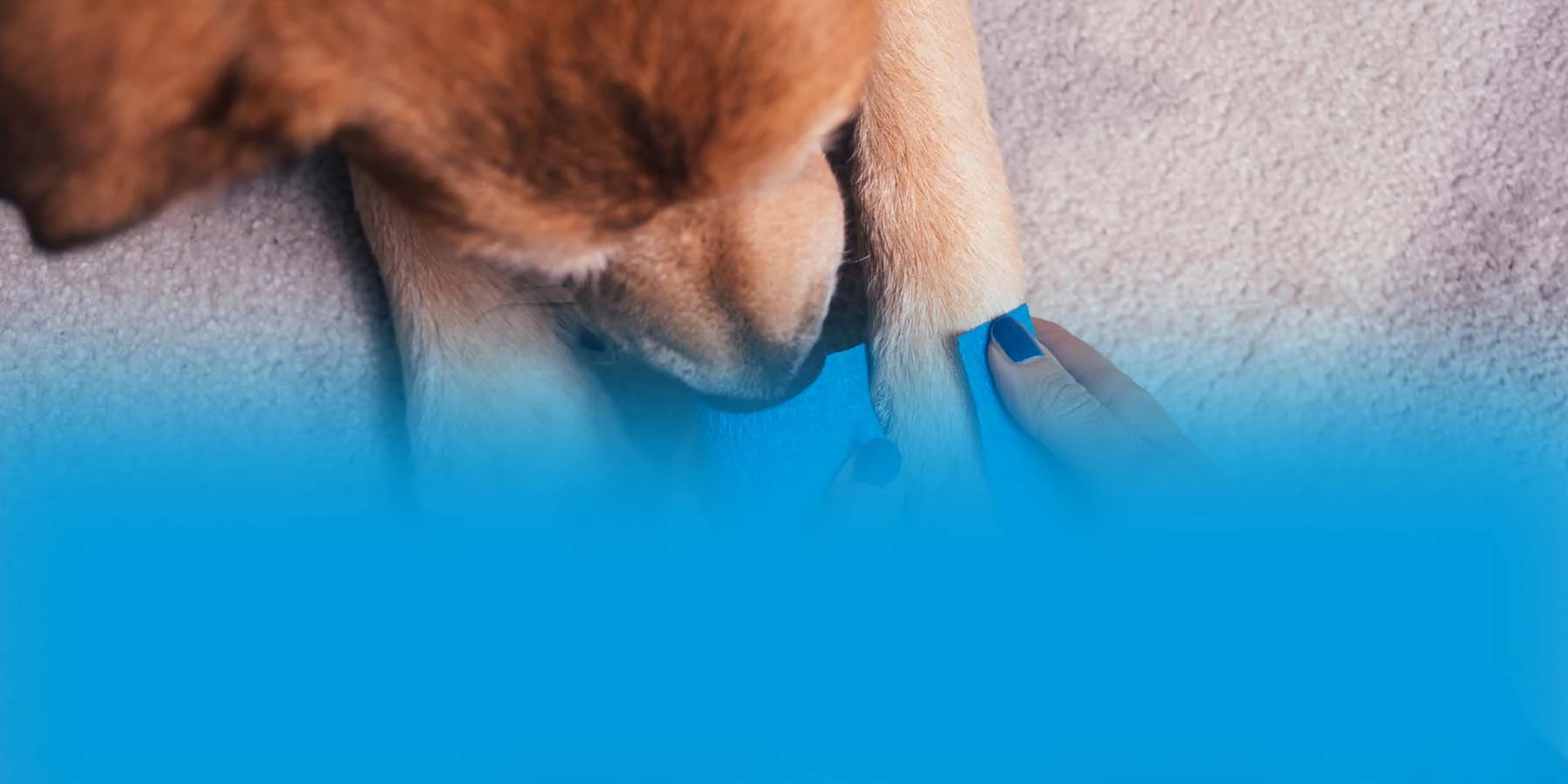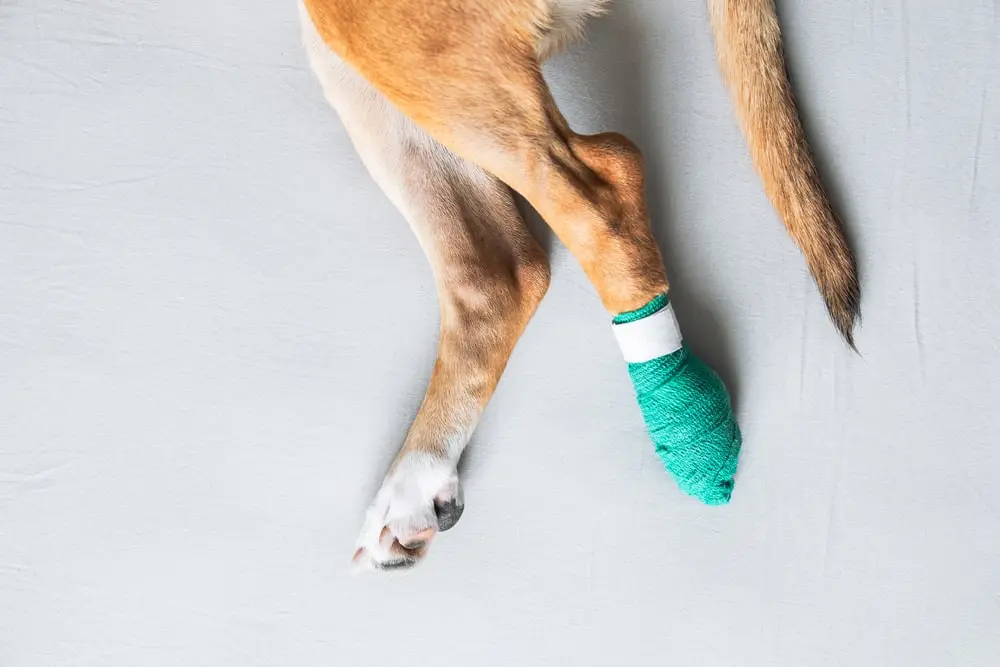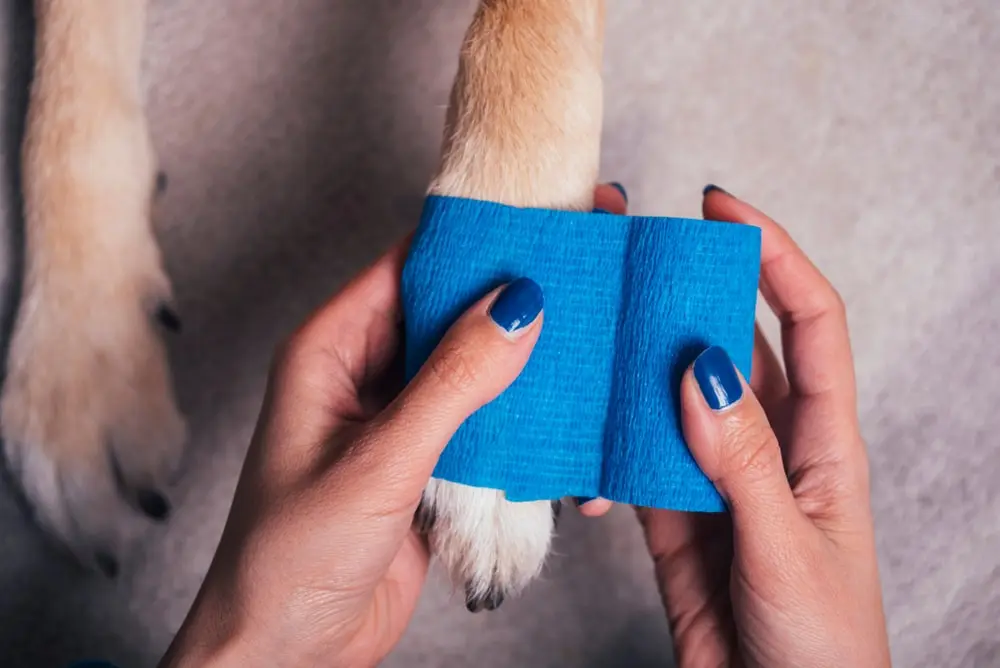PET CARE
How to Wrap a Dog’s Paw and Other Dog Wound Care Tips
No dog owner wants to think of their pooch in pain. Unfortunately, dog paw wounds and other skin wounds are all too common. While bumps, scrapes, and breaks happen, they can get worse if not properly treated. Fortunately, you can learn how to wrap a dog’s paw and take care of their wound or get it protected before seeking professional care.
A safe, clean, and properly applied bandage may be very important in the healing process and could prevent an infection. Properly applying a bandage might help prevent bleeding and additional injury, along with providing some pain relief for your dog.
If you’ve never had to treat a dog wound or injury, learning some basic pet first aid tips and putting together a doggy first aid kit is a good place to start. The following items can help with dog wound care and are a good idea to include in your pet first aid kit:1
- Antiseptic
- Sterile pads and gauze
- Adhesive tape
- Nonstick bandages
- Scissors
- Tweezers
Read on for more tips on how to clean, bandage, and care for dog wounds.
How To Clean a Dog Wound
If you can see a swollen dog paw or if your dog is limping, bleeding, or showing signs of any other injury, you can use the following instructions to care for the wound until you can see your veterinarian:2
- Start by looking for foreign objects in the wound, such as bits of glass, dirt, small rocks, or metal shards. Carefully remove them with tweezers. Placing the paw or injured area in cold water or letting the water run over the wound can also help dislodge any particles. It’s advised that deeply-lodged debris be removed by veterinarians.
- You can disinfect the wound using a mild antibacterial soap and pat it dry with a clean towel or cloth. You may need to clip some hair around the wound using scissors to keep it clean, so be careful and gentle. Unless recommended by your vet, don’t put any disinfectants, ointments, creams, or other chemicals on the wound as it can interfere with healing.3
- If there’s bleeding, apply pressure with a clean towel until it stops. If the bleeding still continues after 10 – 15 minutes, it’s recommended to take your dog to an emergency clinic right away.
Regardless, it’s a good idea to schedule a vet visit to get the wound examined, ideally within 3 days of injury.2 Your vet can take a closer look at the wound and prescribe medication, like antibiotics and painkillers, to help speed up the healing process.
Prefer that a Vet Bandage Your Dog’s Paw?
How To Bandage a Dog’s Paw and Other Open Wounds
Once the wound has been cleaned the next step is to bandage it:2
- Put a nonstick absorbent pad over the wound.
- Wrap a gauze bandage over the nonstick absorbent pad.
- Wrap a layer of adhesive tape over the bandage to secure it in place.
Make sure the bandage isn’t too tightly wrapped — you should be able to fit two fingers between the bandage and your pup’s body. Dog bandages should be changed frequently according to your vet’s instructions. This helps the wound remain clean and free of bacteria. If your dog fiddles with or chews on their bandage, there are anti-lick sprays available to help curb this behavior.
What can you put on a dog wound to help heal it?
While adhesive tape, non-stick bandages, and gauze are great items you can use to dress your dog’s wound, you may not always have access to them the moment an injury happens. In a pinch, you can use clean cotton t-shirts to protect your dog's wound until you can get proper bandaging in place.
You may be able to put certain products on specific dog wounds to help keep it clean and heal — like applying honey on hot spots. However, some products can delay healing, damage tissues, or be toxic to dogs, so it’s best to consult with your vet to determine what’s safe to use. You may be able to use saline solution, warm water, diluted chlorhexidine, iodine solutions, or surgical soap to keep wounds clean.3
Your vet may prescribe topical medication to help promote wound closure, reduce pain, or prevent infection.4 While using Neosporin for dogs may seem like a good idea to help prevent topical infection, your dog could have an allergic reaction to it.5
How to keep a dog bandage on
Keeping the bandage on your dog can prove to be quite challenging, even if you have followed the suggested steps correctly. To keep the bandage in place, here are a couple of tips to consider:
- Keep it dry.
- Don’t leave your pet unsupervised outdoors.
- Consider placing a cone on your dog to prevent them from removing the bandage.
- If the wound is on their paw, place a sock or dog bootie over the bandage.
- If the wound is somewhere on their torso, you might be able to put a loose fitting t-shirt on your pup to keep it covered and protected.
Additional Dog Wound Care Tips
The type of wound your dog has can dictate how you need to care for it after you see your vet. Here are some tips on how to care for open and closed wounds.
Open wound care
Sometimes wounds are left open for treatment or because they can’t be surgically closed.3 This could be because of the placement on your dog’s body like an eye injury or a bite wound high on their leg. Your vet will give you specific instructions to follow, but here are some aftercare tips for open wounds:3
- Keep the wound edges clean and remove any sticky or crusty debris.
- Don’t let your dog pick at or lick the wound. A cone can help prevent this.
- Only administer prescribed medications on the wound. You shouldn’t put anything on the wound that hasn’t been suggested by your vet.
- You can prevent the skin from healing too quickly by gently massaging the skin around the wound when you’re cleaning it.
- Change any bandages according to your vet’s instructions.
Closed wound care
If the wound needed surgery to close it, or the wound was an incision as a result of a procedure (like an ACL surgery), you’ll need to know how to take care of it when your pup gets home from the vet. Here are some aftercare tips for closed wounds:6
- Don’t bathe your dog or let the wound get wet.
- Don’t let your dog pick at or lick the wound. A cone can help prevent this.
- Only administer prescribed medications on the wound. You shouldn’t put anything on the wound that hasn’t been suggested by your vet.
- Inspect the wound twice a day if it’s not bandaged. If it’s bandaged, inspect the wound when you change bandages.
- Follow your vet’s instructions for cleaning the wound, changing bandages, required draining, and any other instructions given after check-ups and when the sutures are removed.
If your dog’s stitches open, it’s best to call your vet — you may have to go back in to get the stitches redone so the healing process can continue.6
Dog Wound Healing Stages
Whether a wound heals normally or it becomes an infected dog wound, the healing stages are important to know so you can spot when something could be off. A dog wound typically goes through these four stages when it’s healing:7
- Inflammation: This stage starts as soon as the wound is inflicted and activates the immune system to fight off any bacteria and start the healing. Common symptoms of this stage can be redness, pain, heat, swelling, and potential lameness.8
- Debridement: This stage comes in a few hours after inflammation sets in and is meant to clean up the wound. You may see pus forming, which helps carry any debris out of the wound.
- Repair: This stage starts a couple of days after the wound was inflicted and is when collagen and new blood vessels begin to bind the wound. If it’s not a closed wound, you may see granulation tissue (moist pink tissue) form along the edges to fill in the wound and eventually start to see the wound shrink.
- Maturation: This stage starts after 2 – 3 weeks and can last for months or years depending on the wound type and severity. This is when scars form to eventually become new skin tissue.
Generally, surgical wounds with sutures can heal much faster because there’s no gap in the skin that needs to be filled in with new tissue.7 However, certain health conditions can slow down the healing process — like anemia or malnutrition — so talk to your vet to get an idea of how long it may take for your dog to fully heal.4
During your pup’s healing process they may be in some pain. Your vet may prescribe specific pain relief medication or tell you what you can give your dog for pain, like baby aspirin or veterinary nonsteroidal anti-inflammatory drugs (NSAIDs).
How to recognize a dog wound infection
An injury is bad enough, but an infection can make matters much worse. As the wound goes through the healing stages, inspect the condition of it. Look for swelling, discoloration, a liquid discharge, or a foul odor — any of these could indicate an infection or compromised blood circulation.2 If untreated, both could become permanent damage. That’s why it’s so important to consult your vet as soon as something seems off.
Infection can happen during the first three stages of healing since the wound is not fully healed.8 Keeping the wound clean and changing bandages often can help reduce the risk of infection. But if an infection does occur, your vet will likely treat it with antibiotics so the healing process can resume.7
Can Pet Insurance Help Lick the Cost of Dog Wound Care?
Cleaning and bandaging your dog’s wound at home isn’t likely to cost an arm and a leg — especially if it’s something small like a bee sting or a scrape in which you can get a quick consultation with your veterinarian over the phone. Vet visits are another matter because wound treatment and repair could run you between $800 and $2,500.9
No pet parent wants a bill to get in the way of the treatment their furry family needs. With a dog insurance policy, you could be reimbursed for up to 100% of the cost of emergency treatment.10 With award-winning11 MetLife Pet Insurance, you can customize your plan to meet your unique needs. Learn more about how pet insurance works or go ahead and get a free quote.
Help Protect Your Pup From Injuries




